| Consideration
of Grappling & Wrestling 
in Renaissance Fencing
by John Clements, ARMA Director
Excerpted from the forthcoming Compendium on Historical
Fencing to be published in 2001 |
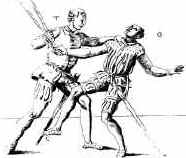 The skills of grappling and the art of wrestling have a long legacy in Europe.
In the early 1500s, many soldiers, scholars, priests, and nobles wrote that wrestling was
important in preparing aristocratic youth for military service. The detailed depictions of
unarmed techniques in many Medieval fencing manuals (such as those by Fiore Dei Liberi and
Hans Talhoffer) are well known and accounts of wrestling and grappling abound in
descriptions of 15th century tournaments and judicial contests. A 1442
tournament fight in Paris "with weapons as we are accustomed to carrying in
battle" included in its fourth article the stipulation "that each of us may help
each other with wrestling, using legs, feet, arms or hands." English knightly
tournaments as late as 1507 allowed combatants "To Wrestle all maner of
wayes" or to fight "with Gripe, or otherwise". The Hispano-Italian
master Pietro Monte in the 1480’s even recognized wrestling as the "foundation
of all fighting", armed or unarmed. Albrecht Duerer’s Fechtbuch of 1512 contains
more material on wrestling than on swordplay, yet the relationship between them is
noticeable. The oldest known fencing text, the late 13th century treatise MS
I.33, even states, "For when one will not cede to the other, but they press one
against the other and rush close, there is almost no use for arms, especially long ones,
but grappling begins, where each seeks to throw down the other or cast him on the ground,
and to harm and overcome him with many other means." But just how all this
heritage relates to the foyning fence of the Renaissance is less well understood. This has
been an area traditionally overlooked by enthusiasts and it is understandable that many
enthusiasts have come to the wrong conclusions. The skills of grappling and the art of wrestling have a long legacy in Europe.
In the early 1500s, many soldiers, scholars, priests, and nobles wrote that wrestling was
important in preparing aristocratic youth for military service. The detailed depictions of
unarmed techniques in many Medieval fencing manuals (such as those by Fiore Dei Liberi and
Hans Talhoffer) are well known and accounts of wrestling and grappling abound in
descriptions of 15th century tournaments and judicial contests. A 1442
tournament fight in Paris "with weapons as we are accustomed to carrying in
battle" included in its fourth article the stipulation "that each of us may help
each other with wrestling, using legs, feet, arms or hands." English knightly
tournaments as late as 1507 allowed combatants "To Wrestle all maner of
wayes" or to fight "with Gripe, or otherwise". The Hispano-Italian
master Pietro Monte in the 1480’s even recognized wrestling as the "foundation
of all fighting", armed or unarmed. Albrecht Duerer’s Fechtbuch of 1512 contains
more material on wrestling than on swordplay, yet the relationship between them is
noticeable. The oldest known fencing text, the late 13th century treatise MS
I.33, even states, "For when one will not cede to the other, but they press one
against the other and rush close, there is almost no use for arms, especially long ones,
but grappling begins, where each seeks to throw down the other or cast him on the ground,
and to harm and overcome him with many other means." But just how all this
heritage relates to the foyning fence of the Renaissance is less well understood. This has
been an area traditionally overlooked by enthusiasts and it is understandable that many
enthusiasts have come to the wrong conclusions.
|
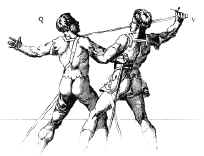 Nonetheless, all historical armed combat (Medieval and
Renaissance, cutting or thrusting) involved some degree of grappling and
wrestling techniques. But, as few Renaissance fencing manuals include detailed sections on
grappling and wrestling or even discuss seizures and disarms, the popular view has been
that they were not used or were viewed with disdain. Besides, aren’t unarmed and
pugilistic attacks merely unskilled "thuggery" practiced only by the lower
classes? After all, surely one should not need to wrestle if one knows the sword "to
perfection"? (…and yet how many are "perfect" with their sword, we
might ask?). Nonetheless, all historical armed combat (Medieval and
Renaissance, cutting or thrusting) involved some degree of grappling and
wrestling techniques. But, as few Renaissance fencing manuals include detailed sections on
grappling and wrestling or even discuss seizures and disarms, the popular view has been
that they were not used or were viewed with disdain. Besides, aren’t unarmed and
pugilistic attacks merely unskilled "thuggery" practiced only by the lower
classes? After all, surely one should not need to wrestle if one knows the sword "to
perfection"? (…and yet how many are "perfect" with their sword, we
might ask?).
|
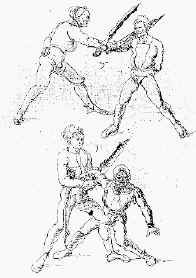 This common view makes perfect sense, after
all, as a slender cut-and-thrust sword or rapier is a weapon whose characteristics are
perfectly suited to keeping an opponent off and killing him at range. Intentionally
closing-in to resort to hands-on brute strength would seem antithetical to the very nature
and advantage of the weapon. In actuality, the matter is that such actions were not
primitive, but advanced techniques that required considerable practice and skill to
execute –and knowing them could make a fighter a more well-rounded and dangerous
opponent in combat. Yet, fencing historians have typically seen these advanced techniques
as being crudities and mere "tricks". Part of this prejudice perhaps stems from
the surviving 18th & 19th century view of swordplay as being
essentially that of personal "duel of honor" or gentlemanly private quarrel. The
traditional focus there has been on fencing as "blade on blade" action rather
than on "fighting" with swords in battle or sudden urban assault. This was not
the case in the 1500’s and 1600’s. Armed fighting ranged from all manner of
encounters with all manner of bladed weapons. This common view makes perfect sense, after
all, as a slender cut-and-thrust sword or rapier is a weapon whose characteristics are
perfectly suited to keeping an opponent off and killing him at range. Intentionally
closing-in to resort to hands-on brute strength would seem antithetical to the very nature
and advantage of the weapon. In actuality, the matter is that such actions were not
primitive, but advanced techniques that required considerable practice and skill to
execute –and knowing them could make a fighter a more well-rounded and dangerous
opponent in combat. Yet, fencing historians have typically seen these advanced techniques
as being crudities and mere "tricks". Part of this prejudice perhaps stems from
the surviving 18th & 19th century view of swordplay as being
essentially that of personal "duel of honor" or gentlemanly private quarrel. The
traditional focus there has been on fencing as "blade on blade" action rather
than on "fighting" with swords in battle or sudden urban assault. This was not
the case in the 1500’s and 1600’s. Armed fighting ranged from all manner of
encounters with all manner of bladed weapons.
|
|
|
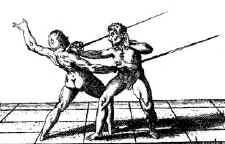 Yet, because approval of grappling
and wrestling in the period was inconsistent and often curtailed
during fencing practice, understanding its true value can
be confusing now for students unfamiliar with either the
actual evidence or the actual techniques. In the early 1500’s
the Italian solider-priest Celio Calacagnini listed wrestling
as an exercise required for preparing upper-class youths
for military service. In 1528, the courtier Baldassare Castiglione
wrote, " it is of the highest importance to know how
to wrestle, since this often accompanies combat on foot."
In 1531 the English scholar and diplomat Sir Thomas Elyot
wrote, "There be divers maners of wrastlinges"
and "undoubtedly it shall be founde profitable in warres,
in case that a capitayne shall be constrayned to cope with
his aduersary hande to hande, hauyng his weapon broken or
loste. Also it hath ben sene that the waiker persone, by
the sleight of wrastlyng, hath ouerthrowen the strenger,
almost or he coulde fasten on the other any violent stroke." Yet, because approval of grappling
and wrestling in the period was inconsistent and often curtailed
during fencing practice, understanding its true value can
be confusing now for students unfamiliar with either the
actual evidence or the actual techniques. In the early 1500’s
the Italian solider-priest Celio Calacagnini listed wrestling
as an exercise required for preparing upper-class youths
for military service. In 1528, the courtier Baldassare Castiglione
wrote, " it is of the highest importance to know how
to wrestle, since this often accompanies combat on foot."
In 1531 the English scholar and diplomat Sir Thomas Elyot
wrote, "There be divers maners of wrastlinges"
and "undoubtedly it shall be founde profitable in warres,
in case that a capitayne shall be constrayned to cope with
his aduersary hande to hande, hauyng his weapon broken or
loste. Also it hath ben sene that the waiker persone, by
the sleight of wrastlyng, hath ouerthrowen the strenger,
almost or he coulde fasten on the other any violent stroke."
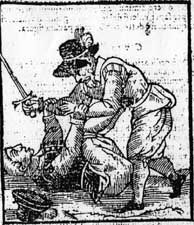 In
1575, Michel de Montaigne, the French Renaissance thinker,
essayist, and courtier, wrote "our very exercises and
recreations, running, wrestling …and fencing".
In the notorious 1547 duel between the nobles Jarnac and
Chastaignerai, Jarnac was so concerned at Chastaignerai’s
well known skill as a wrestler (not to mention fencing)
that to avoid the chance of a close struggle, he insisted
both parties each wear two daggers. Alfred Hutton’s
account from Vulson de la Colombière’s in 1549 of a
judicial combat between one D’aguerre and Fendilles
states, "D’aguerre let fall his sword, and being
an expert wrestler (for be it understood that no one in
those days was considered a complete man-at-arms unless
he was proficient in the wrestling art), threw his enemy,
held him down, and, having disarmed him of his morion, dealt
him many severe blows on the head and face with it…". In
1575, Michel de Montaigne, the French Renaissance thinker,
essayist, and courtier, wrote "our very exercises and
recreations, running, wrestling …and fencing".
In the notorious 1547 duel between the nobles Jarnac and
Chastaignerai, Jarnac was so concerned at Chastaignerai’s
well known skill as a wrestler (not to mention fencing)
that to avoid the chance of a close struggle, he insisted
both parties each wear two daggers. Alfred Hutton’s
account from Vulson de la Colombière’s in 1549 of a
judicial combat between one D’aguerre and Fendilles
states, "D’aguerre let fall his sword, and being
an expert wrestler (for be it understood that no one in
those days was considered a complete man-at-arms unless
he was proficient in the wrestling art), threw his enemy,
held him down, and, having disarmed him of his morion, dealt
him many severe blows on the head and face with it…".
|
|
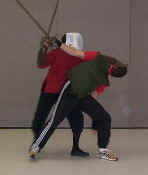 A Ritterakedemie or "Knight’s School" was
reportedly set up in 1589 at Tübingen in Germany to instruct aristocratic youths in
skills which included wrestling, fencing, riding, dancing, tennis, and firearms. Joachim
Meyer offered significant elements of grappling and wrestling with swords in his Fechtbuch
of 1570 and in the 1580’s the French general Francois de la Noue advocated wrestling
in the curriculum of military academies and the famed chronicler of duels, Brantome, also
tells us that wrestling was highly regarded at the French court. The Bolognese master,
Lelio de Tedeschi, even produced a manual on the art of disarming in 1603. In 1625,
Englishman Richard Peeke fought in a rapier duel at Cadiz, defeating the Spaniard Tiago by
sweeping his legs out from under him after trapping his blade with his hilt. In
1617 Joseph Swetnam commented on the value of skill in wrestling for staff fighting. But
as Dr. Anglo has pointed out, in 1622, Englishman Henry Peacham questioned whether
"throwing and wrestling" were more befitting common soldiers rather than
nobility, while his contemporary Lord Herbert of Cherbury who studied martial arts in
France, found them "qualities of great use". At the turn of the 17th
century in France, the celebrated rapier duelists Lagarde and Bazanez came into conflict
(the celebrated "duel of the hat") and ended up on the ground violently stabbing
and fighting each other. A Ritterakedemie or "Knight’s School" was
reportedly set up in 1589 at Tübingen in Germany to instruct aristocratic youths in
skills which included wrestling, fencing, riding, dancing, tennis, and firearms. Joachim
Meyer offered significant elements of grappling and wrestling with swords in his Fechtbuch
of 1570 and in the 1580’s the French general Francois de la Noue advocated wrestling
in the curriculum of military academies and the famed chronicler of duels, Brantome, also
tells us that wrestling was highly regarded at the French court. The Bolognese master,
Lelio de Tedeschi, even produced a manual on the art of disarming in 1603. In 1625,
Englishman Richard Peeke fought in a rapier duel at Cadiz, defeating the Spaniard Tiago by
sweeping his legs out from under him after trapping his blade with his hilt. In
1617 Joseph Swetnam commented on the value of skill in wrestling for staff fighting. But
as Dr. Anglo has pointed out, in 1622, Englishman Henry Peacham questioned whether
"throwing and wrestling" were more befitting common soldiers rather than
nobility, while his contemporary Lord Herbert of Cherbury who studied martial arts in
France, found them "qualities of great use". At the turn of the 17th
century in France, the celebrated rapier duelists Lagarde and Bazanez came into conflict
(the celebrated "duel of the hat") and ended up on the ground violently stabbing
and fighting each other. |
 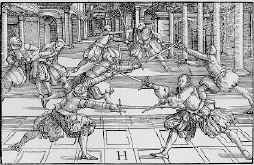
|
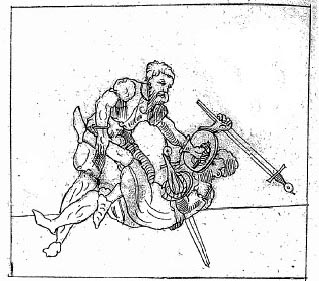 There is evidence close-in techniques were excluded from the German
Fechtschulen events of the 1500s where, in order to perform safe displays, rules were in
place to prevent such techniques. Similarly, the 1573 Sloane manuscript of the London
Masters of Defence states that in Prize Playing events "who soever dothe play agaynst
ye prizor, and doth strike his blowe and close withall so that the prizor cannot strike
his blowe after agayne, shall Wynn no game for anny Veneye". The implication in such
cases is that while closing and seizing is effective and understood, it is inappropriate
for the public display intended to show a student’s skill at defending and delivering
blows. In 1579, Heinrich Von Gunterrodt noted that "Fencing is a worthy, manly, and
most noble Gymnastic art, established by principles of nature…which serves both
gladiator and soldier, indeed everyone, in …battles, and single-combats, with every
hand-to-hand weapon, and also wrestling, for strongly defending, and achieving victory
over." Von Gunterrodt, also observed: in fencing, "when one will not cede to the
other, but they press one against the other and rush close, there is almost no use for
arms, especially long ones, but grappling begins, where each seeks to throw down the other
or cast him on the ground, and to harm and overcome him with many other means." There is evidence close-in techniques were excluded from the German
Fechtschulen events of the 1500s where, in order to perform safe displays, rules were in
place to prevent such techniques. Similarly, the 1573 Sloane manuscript of the London
Masters of Defence states that in Prize Playing events "who soever dothe play agaynst
ye prizor, and doth strike his blowe and close withall so that the prizor cannot strike
his blowe after agayne, shall Wynn no game for anny Veneye". The implication in such
cases is that while closing and seizing is effective and understood, it is inappropriate
for the public display intended to show a student’s skill at defending and delivering
blows. In 1579, Heinrich Von Gunterrodt noted that "Fencing is a worthy, manly, and
most noble Gymnastic art, established by principles of nature…which serves both
gladiator and soldier, indeed everyone, in …battles, and single-combats, with every
hand-to-hand weapon, and also wrestling, for strongly defending, and achieving victory
over." Von Gunterrodt, also observed: in fencing, "when one will not cede to the
other, but they press one against the other and rush close, there is almost no use for
arms, especially long ones, but grappling begins, where each seeks to throw down the other
or cast him on the ground, and to harm and overcome him with many other means." |
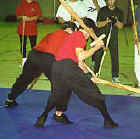 George
Silver’s views of 1599 advocating "gryps and seizures" in swordplay are
well known. Interestingly though, Silver lamented how such things were no longer being
taught by teachers of defence, saying "…there are now in these dayes no gripes,
closes, wrestlings, striking with the hilts, daggers, or bucklers, used in
Fence-schools". However, Silver also describes situations which are quite familiar
and reasonable to those who today practice rapier fencing with more inclusive guidelines
for intentional close-contact. Silver, in his Paradoxes of Defence, section 31,
actually complains that the rapier’s excessive length allows for close-in
fighting without much fear because there is little threat to prevent it once the point is
displaced. He writes: "Of the single rapier fight between valiant men, having both
skill, he that is the best wrestler, or if neither of them can wrestle, the strongest man
most commonly kills the other, or leaves him at his mercy". He then describes what
happens typically when the fighters both rush together, explaining: George
Silver’s views of 1599 advocating "gryps and seizures" in swordplay are
well known. Interestingly though, Silver lamented how such things were no longer being
taught by teachers of defence, saying "…there are now in these dayes no gripes,
closes, wrestlings, striking with the hilts, daggers, or bucklers, used in
Fence-schools". However, Silver also describes situations which are quite familiar
and reasonable to those who today practice rapier fencing with more inclusive guidelines
for intentional close-contact. Silver, in his Paradoxes of Defence, section 31,
actually complains that the rapier’s excessive length allows for close-in
fighting without much fear because there is little threat to prevent it once the point is
displaced. He writes: "Of the single rapier fight between valiant men, having both
skill, he that is the best wrestler, or if neither of them can wrestle, the strongest man
most commonly kills the other, or leaves him at his mercy". He then describes what
happens typically when the fighters both rush together, explaining:
|
"When two valiant men of skill at single rapier do fight, one or both of them most
commonly standing upon their strength or skill in wrestling, will presently seek to run
into the close…But happening both of one mind, they rather do bring themselves
together. That being done, no skill with rapiers avail, they presently grapple fast their
hilts, their wrists, arms, bodies or necks, as in …wrestling, or striving together,
they may best find for their advantages. Whereby it most commonly false out, that he that
is the best wrestler, or strongest man (if neither of them can wrestle) overcomes,
wrestling by strength, or fine skill in wrestling, the rapier from his adversary, or
casting him from him, wither to the ground, or to such distance, that he may by reason
thereof, use the edge or point of his rapier, to strike or thrust him, leaving him dead or
alive at his mercy."
|
| In his section 34, Of the long single rapier, or rapier and poniard
fight between two unskillful men being valiant, Silver also observes: |
"When two unskillful men (being valiant) shall fight with long single rapiers,
there is less danger in that kind of fight, by reason of their distance in convenient
length, weight, and unwieldiness, than is with short rapiers, whereby it comes to pass,
that what hurt shall happen to be done, if any with the edge or point of their rapiers is
done in a moment, and presently will grapple and wrestle together, wherein most commonly
the strongest or best wrestler overcomes, and the like fight falls out between them, at
the long rapier and poniard, but much more deadly, because instead of close and wresting,
they fall most commonly to stabbing with their poniards."
|
|
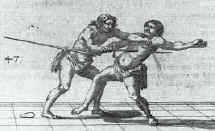 Of course, some might argue
Silver was not a "rapier master" and so did not understand "proper"
fencing. Regardless, he was obviously an experience, highly skilled martial artist and
expert swordsman who had seen valid methods of rapier fighting in actual use. Then
there is the case of "Austin Bagger, a very tall gentleman of his hands, not standing
much upon his skill" who Silver describes as having with his sword and buckler fought
the "Italian teacher of offense", Signior Rocco with his two hand sword. Silver
relates how Bagger "presently closed with him, and struck up his heels, and cut him
over the breech, and trod upon him, and most grievously hurt him under his feet."
Which means he charged forward, swept his legs out from under him, slashed his
rear, and then stomped on him a few times while he was down. Of course, some might argue
Silver was not a "rapier master" and so did not understand "proper"
fencing. Regardless, he was obviously an experience, highly skilled martial artist and
expert swordsman who had seen valid methods of rapier fighting in actual use. Then
there is the case of "Austin Bagger, a very tall gentleman of his hands, not standing
much upon his skill" who Silver describes as having with his sword and buckler fought
the "Italian teacher of offense", Signior Rocco with his two hand sword. Silver
relates how Bagger "presently closed with him, and struck up his heels, and cut him
over the breech, and trod upon him, and most grievously hurt him under his feet."
Which means he charged forward, swept his legs out from under him, slashed his
rear, and then stomped on him a few times while he was down.
|
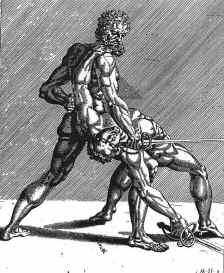 Hutton tells us how in the year 1626, the Marquis de Beuvron and Francois de
Montmorency, Comte de Boutteville, the notorious rabid duelist and bully, fought a duel
together in which both attacked "each other so furiously that they soon come to such
close quarters that their long rapiers are useless. They throw them aside, and, grappling
with one another, attempt to bring their daggers into play." In 1671 an affray took
place in Montreal, Canada, between Lieutenant de Carion and Ensign de Lormeau. While
walking home with his wife, de Lormeau was confronted by de Carion backed by two friends.
Provoked into fighting by de Carion, both men drew swords and exchanged blows. De Lormeau
was wounded three times, including wounds to the head and arm. Both wrestled briefly
before de Carion struck de Lormeau repeatedly on the head with his pommel. They were then
separated by some five passing onlookers and both combatants survived. Hutton tells us how in the year 1626, the Marquis de Beuvron and Francois de
Montmorency, Comte de Boutteville, the notorious rabid duelist and bully, fought a duel
together in which both attacked "each other so furiously that they soon come to such
close quarters that their long rapiers are useless. They throw them aside, and, grappling
with one another, attempt to bring their daggers into play." In 1671 an affray took
place in Montreal, Canada, between Lieutenant de Carion and Ensign de Lormeau. While
walking home with his wife, de Lormeau was confronted by de Carion backed by two friends.
Provoked into fighting by de Carion, both men drew swords and exchanged blows. De Lormeau
was wounded three times, including wounds to the head and arm. Both wrestled briefly
before de Carion struck de Lormeau repeatedly on the head with his pommel. They were then
separated by some five passing onlookers and both combatants survived. |
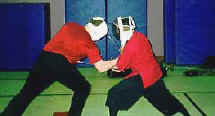 Closing in to strike, to
grab, trip, throw, or push the opponent down is seen in countless Renaissance fencing
manuals from the cut-and-thrust style swords of Marozzo in 1536 to the slender rapier of
Giovanni Lovino in 1580 and that of L'Lange in 1664. Jacob Wallhausen’s 1616
depictions of military combat (armored and unarmored) show much the same. Dr. Sydney Anglo
calls this desperate armed or unarmed combat "all-in fighting" as opposed to
formal duels with rules, and describes it as: "one other area of personal combat
which was taught by masters throughout Europe, and was practiced at every level of the
social hierarchy whether the antagonists were clad in defensive armor or not". He
adds that, "Even in Spain, where it might be thought that mathematical and
philosophical speculation had eliminated such sordid realities, wrestling tricks were
still taught by the masters –as well illustrated in early seventeenth-century
manuscripts treatises by Pedro de Heredia, cavalry captain and member of the war council
of the King of Spain". Heredia’s illustrations of rapier include several
effective close-in actions that hark back to similar techniques of Marozzo and even Fiore
Dei Liberi in 1410. Closing in to strike, to
grab, trip, throw, or push the opponent down is seen in countless Renaissance fencing
manuals from the cut-and-thrust style swords of Marozzo in 1536 to the slender rapier of
Giovanni Lovino in 1580 and that of L'Lange in 1664. Jacob Wallhausen’s 1616
depictions of military combat (armored and unarmored) show much the same. Dr. Sydney Anglo
calls this desperate armed or unarmed combat "all-in fighting" as opposed to
formal duels with rules, and describes it as: "one other area of personal combat
which was taught by masters throughout Europe, and was practiced at every level of the
social hierarchy whether the antagonists were clad in defensive armor or not". He
adds that, "Even in Spain, where it might be thought that mathematical and
philosophical speculation had eliminated such sordid realities, wrestling tricks were
still taught by the masters –as well illustrated in early seventeenth-century
manuscripts treatises by Pedro de Heredia, cavalry captain and member of the war council
of the King of Spain". Heredia’s illustrations of rapier include several
effective close-in actions that hark back to similar techniques of Marozzo and even Fiore
Dei Liberi in 1410. |

|
| The chronicler of duels, Brantome, tells us of a judicial duel in the
mid-1500’s wherein the Baron de Gueerres fought one Fendilles. Having received a
terrible thrust in the thigh, the Baron availed himself of his wrestling skills and
"closed with his antagonist and bore him to the ground; and there the two lay and
struggled". He also relates a sword & dagger duel between the Spanish Captain
Alonso de Sotomayor and the knight Bayard. After some figting Sotomayor missed a thrust
which Bayard answered by deeply piercing his throat that he could not withdraw his weapon.
Sotomayor was still able to grapple with Bayard so that both fell where Bayard then
managed to stab Sotomayor in the face with his dagger. Some would still give us the
impression today that personal combat in the Renaissance consisted only of cavaliers and
courtiers formally dueling each other and apparrently no gentleman or courtier in the
period ever fought under any other condition or for any other reason other than affairs
of honor. Of course, it must be thoroughly understood that it was the Renaissance
aristocracy who were primarily recording accounts of duels and frays and who naturally
wrote almost exclusively about combats among their own social class. Naturally, proper
duels (illegal or not) were far more interesting to them than everyday fights (by gentry
or commoner) which garnered neither reputation nor honor. But the actual evidence from the
period suggests a very different character than a conception of simple
"honorable" swordplay. |

|
| In the 1470’s Paris de Puteo had noted that in a formal duel if a
sword was broken he might properly fighting by twisting his opponent’s arm, biting
him, etc. But by 1553, Venetian, Antonio Possevino stated that to purposely discard a
serviceable weapon in favor of fist fighting or to engage in wrestling, kicking, etc. was
dishonorable because the contest should be a test of strength not of the body. Such
actions were deemed appropriate for dueling gentry if conducted within the course
of an armed struggle --that is, they were allowable while still armed. From the
early 1500’s there is the account of a formal duel sanctioned by the Grand Duke
Alphonso in Ferrara, Italy where the challenged party (in an obvious attempt to prevent
such actions) attempted to wear armor with sharp projections at places where an adversary
would typically try to take hold. Objecting, the Duke summoned forth a smith to file down
the offending sharp points on grounds that such was not the proper manner of armor worn by
knights in war. |
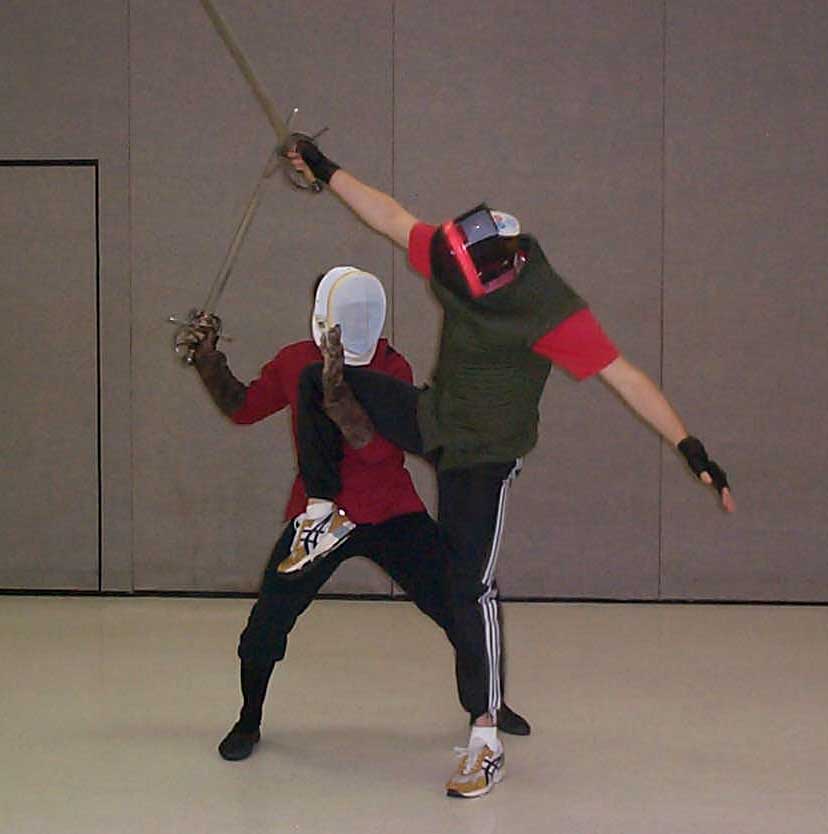 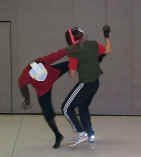
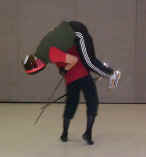 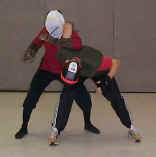
|
| One late 1500s duel between a Signor Amadeo and one Crequi was fought on
an island in the Rhone. Crequi brought Amadeo to the ground and without more ado killed
him there (Amadeo’s relatives later complained of the undignified recumbent manner in
which their fellow perished). Giraldi Cinzio describes a duel of c. 1564 in which an old
fencing master named Pirro at Beneveto fought with Sergesto, a young former student. Pirro
struck him on the back of the knee with the flat of his blade, pushed him to the ground,
disarmed him and, seizing his throat, made him surrender. |
|
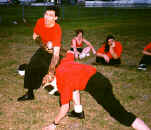 The master
Salvatore Fabris in 1606 depicted a range of close-in and second-hand actions even showing
a closing to take down the opponent by grabbing him around the waist. Yet Fabris only
included material on grips and seizing reluctantly, because his text was focused on
defense with the sword in a way so effective that gentlemen would "never need to come
to grips on the seizing of swords". As with other masters, his method was essentially
aimed at encounters of honor within the code duello. Apparently though, whatever
his opinion of them as appropriate for his readers he did understand and teach these other
skills in some way to prepare his students for them. Fabris’ close-in moves were
influential enough for several later rapier masters, including Heussler in 1615,
L’Lange in 1664, and Porath as late as 1693, to all copy them (Siegmund Weischner in
his small-sword treatise, Die Ritterliche Geschicklichkeit im Fechten, of 1765 also
shows a variety of closing actions and grapples similar to Fabris). The master
Salvatore Fabris in 1606 depicted a range of close-in and second-hand actions even showing
a closing to take down the opponent by grabbing him around the waist. Yet Fabris only
included material on grips and seizing reluctantly, because his text was focused on
defense with the sword in a way so effective that gentlemen would "never need to come
to grips on the seizing of swords". As with other masters, his method was essentially
aimed at encounters of honor within the code duello. Apparently though, whatever
his opinion of them as appropriate for his readers he did understand and teach these other
skills in some way to prepare his students for them. Fabris’ close-in moves were
influential enough for several later rapier masters, including Heussler in 1615,
L’Lange in 1664, and Porath as late as 1693, to all copy them (Siegmund Weischner in
his small-sword treatise, Die Ritterliche Geschicklichkeit im Fechten, of 1765 also
shows a variety of closing actions and grapples similar to Fabris).
|
|
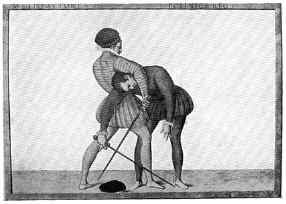 Given the range of techniques and actions is in the historical accounts, a
pattern is discernable. In a 1613 rapier duel between Sir John Heidon, the Earl of Dorset,
and Lord Bruce, Heidon not only put his opponent on the ground, but jumped him afterward.
Heidon wrote: "And there we wrestled for the two greatest and dearest prizes we could
ever expect trial for –life and honor. Myself being wounded…I struck…passed
through his body, and drawing back my sword, repassed through again…I easily became
master of him, laying him on his back, when, being upon him …I could not find in my
heart to offer him any more violence, only keeping him down". In a single combat
during the English Civil Wars, Scotsman Sir Ewen Lochiel, chief of the clan Cameron fought
a valiant English officer after several moments and exchange of blows, Lochiel finally
disarmed his antagonist and they wrestled until they fell to the ground grappling. The
Englishman gained the advantage but Lochiel managed to get his hands free, grabbed his
foes collar and: "fastening his teeth upon his throat, brought away a mouthful of
flesh, which, he said, was ‘the sweetest bit he ever had in his life.’" Given the range of techniques and actions is in the historical accounts, a
pattern is discernable. In a 1613 rapier duel between Sir John Heidon, the Earl of Dorset,
and Lord Bruce, Heidon not only put his opponent on the ground, but jumped him afterward.
Heidon wrote: "And there we wrestled for the two greatest and dearest prizes we could
ever expect trial for –life and honor. Myself being wounded…I struck…passed
through his body, and drawing back my sword, repassed through again…I easily became
master of him, laying him on his back, when, being upon him …I could not find in my
heart to offer him any more violence, only keeping him down". In a single combat
during the English Civil Wars, Scotsman Sir Ewen Lochiel, chief of the clan Cameron fought
a valiant English officer after several moments and exchange of blows, Lochiel finally
disarmed his antagonist and they wrestled until they fell to the ground grappling. The
Englishman gained the advantage but Lochiel managed to get his hands free, grabbed his
foes collar and: "fastening his teeth upon his throat, brought away a mouthful of
flesh, which, he said, was ‘the sweetest bit he ever had in his life.’" |
|
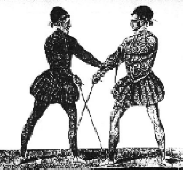 In his
1657 work on rapiers, weapons, and unarmed combat the German master of arms, Johan Georg
Pascha, reveals an extraordinary range of unarmed techniques (which some have said
resemble styles of Chinese wing chung kung fu). It would not be difficult to believe that
Pascha, who was also a rapier master, would have utilized these in his fencing method. We
must consider that since he did not show them does not necessarily serve as evidence he
excluded them. A fighter always uses what he knows. As Dr. Anglo relates, "For many
centuries, the fighting taught by professional masters was relevant either on the
battlefield, in the formal duel or in a brawl. The space given to the difficult skills
required in each case varied from author to author, place to place, and (certainly) from
time to time." Dr. Anglo points out that in the late 1600s, the philosopher John
Locke wrote that an unskilled fencer with skill in wrestling has the "odds against a
moderate fencer". Locke believed for a man to prepare his son for duels, "I had
much rather mine should be a good wrestler than an ordinary fencer; which the most any
gentleman can attain to in it, unless he will be constantly in the fencing school, and
every day exercising." Scots master, Sir William Hope in his 1707, "New Method" fencing book also speaks highly of grips
and tripping (although not as something to be casually practiced in class). In 1720, Sir
Thomas Parkyns in his Cornish-Hugg Wrestler explains,
"I illustrate how useful Wrestling is to a Gentleman in Fencing, in the following
Example of Parrying, and leave it to the ingenious, to make a farther Application as oft
as an Opportunity shall offer itself." In his
1657 work on rapiers, weapons, and unarmed combat the German master of arms, Johan Georg
Pascha, reveals an extraordinary range of unarmed techniques (which some have said
resemble styles of Chinese wing chung kung fu). It would not be difficult to believe that
Pascha, who was also a rapier master, would have utilized these in his fencing method. We
must consider that since he did not show them does not necessarily serve as evidence he
excluded them. A fighter always uses what he knows. As Dr. Anglo relates, "For many
centuries, the fighting taught by professional masters was relevant either on the
battlefield, in the formal duel or in a brawl. The space given to the difficult skills
required in each case varied from author to author, place to place, and (certainly) from
time to time." Dr. Anglo points out that in the late 1600s, the philosopher John
Locke wrote that an unskilled fencer with skill in wrestling has the "odds against a
moderate fencer". Locke believed for a man to prepare his son for duels, "I had
much rather mine should be a good wrestler than an ordinary fencer; which the most any
gentleman can attain to in it, unless he will be constantly in the fencing school, and
every day exercising." Scots master, Sir William Hope in his 1707, "New Method" fencing book also speaks highly of grips
and tripping (although not as something to be casually practiced in class). In 1720, Sir
Thomas Parkyns in his Cornish-Hugg Wrestler explains,
"I illustrate how useful Wrestling is to a Gentleman in Fencing, in the following
Example of Parrying, and leave it to the ingenious, to make a farther Application as oft
as an Opportunity shall offer itself."
|
|
 Even
into the 1700's there are notable accounts of grappling,
wrestling and all-out fighting occuring during upper-class
duels between skilled fencers. In a 1750 small-sword
duel between two German noblemen, Swiegel and Freychappel,
the combat lasted nearly an hour during which both
were many times wounded. Eventually, Freychappel
in trying to rush his opponent, tripped and fell
and was instantly run through and killed by Swiegel.
In his 1771 fencer’s guide for broadsword,
A. Lonnergan at one point instructs, "When
I begin to advance the left hand to disarm you,
spring back, making a blow at it; or, if you think
yourself as powerful as your adversary, oppose force
to force, then the weaker must go to the ground,
if some knowledge of wrestling does not prevent
it." In 1772, a duel between Richard
Sheridan and Captain Mathews, after missing with
pistols, they closed with small-swords, which were
each broken on the first lunge. "They
then fought with the broken parts until each received
many wounds, Sheridan some very dangerous ones.
They at last fell to the ground and fought until
separated by their seconds, Mr. Sheridan being borne
from the field with a portion of his antagonist's
weapon sticking through an ear, his breast-bone
touched, his whole body covered with wounds and
blood, and his face nearly beaten to a jelly with
the hilt of Matthew's' sword." Even
into the 1700's there are notable accounts of grappling,
wrestling and all-out fighting occuring during upper-class
duels between skilled fencers. In a 1750 small-sword
duel between two German noblemen, Swiegel and Freychappel,
the combat lasted nearly an hour during which both
were many times wounded. Eventually, Freychappel
in trying to rush his opponent, tripped and fell
and was instantly run through and killed by Swiegel.
In his 1771 fencer’s guide for broadsword,
A. Lonnergan at one point instructs, "When
I begin to advance the left hand to disarm you,
spring back, making a blow at it; or, if you think
yourself as powerful as your adversary, oppose force
to force, then the weaker must go to the ground,
if some knowledge of wrestling does not prevent
it." In 1772, a duel between Richard
Sheridan and Captain Mathews, after missing with
pistols, they closed with small-swords, which were
each broken on the first lunge. "They
then fought with the broken parts until each received
many wounds, Sheridan some very dangerous ones.
They at last fell to the ground and fought until
separated by their seconds, Mr. Sheridan being borne
from the field with a portion of his antagonist's
weapon sticking through an ear, his breast-bone
touched, his whole body covered with wounds and
blood, and his face nearly beaten to a jelly with
the hilt of Matthew's' sword." |
|
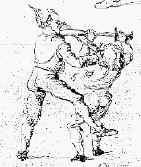 That some Renaissance masters and courtiers did frown on these close fighting
actions is true. The view that a lengthy agile sword should alone be sufficient for
defense is a reasonable one (and is highly reminiscent today of the recent
grappling/ground-fighting deficiency so effectively argued against the more traditional
"stand-up kick/punch" martial artists). It is perfectly reasonable that two
gentlemen would prefer to have an "honorable" quarrel settled by "sword
skill", rather than risk "scuffling in the dirt" and getting bashed in the
face (of which there are several accounts). But just as with schools of modern martial
arts or knife-fighting or hand-gun training now, there were theories of fighting back then
that were more ideal than reality. There were also styles that felt no cause to address
certain possibilities that would be more or less unlikely to be employed by the parties in
a formal aristocratic duel. That some Renaissance masters and courtiers did frown on these close fighting
actions is true. The view that a lengthy agile sword should alone be sufficient for
defense is a reasonable one (and is highly reminiscent today of the recent
grappling/ground-fighting deficiency so effectively argued against the more traditional
"stand-up kick/punch" martial artists). It is perfectly reasonable that two
gentlemen would prefer to have an "honorable" quarrel settled by "sword
skill", rather than risk "scuffling in the dirt" and getting bashed in the
face (of which there are several accounts). But just as with schools of modern martial
arts or knife-fighting or hand-gun training now, there were theories of fighting back then
that were more ideal than reality. There were also styles that felt no cause to address
certain possibilities that would be more or less unlikely to be employed by the parties in
a formal aristocratic duel.
|
|
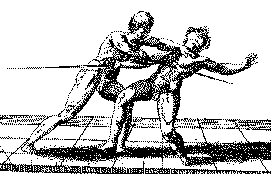 Yet,
because a Renaissance master of arms produced one text on one aspect of fighting (i.e.,
rapier dueling) for one particular audience, does it necessarily mean that we can assume
he was not at all adept at other styles of sword or rapier fighting? When reconstructing
aspects of Renaissance fencing today, it is narrow and self-defeating to attempt to
canonize the minority of masters who either disapproved of or failed to address close
fighting from those who did. As Dr. Anglo has concluded, "Whatever the theoretical
status of wrestling among the learned and knightly classes, it is obvious from surviving
treatises that, up to the early seventeenth century and even beyond, many master of arms
recognized the advantage bestowed upon their pupils by the physical exercise of wrestling
– in order to develop agility, strength, and dexterity – and by practicing
unarmed combat to use against the assaults of an armed assailant or in any other mortal
affray". Yet,
because a Renaissance master of arms produced one text on one aspect of fighting (i.e.,
rapier dueling) for one particular audience, does it necessarily mean that we can assume
he was not at all adept at other styles of sword or rapier fighting? When reconstructing
aspects of Renaissance fencing today, it is narrow and self-defeating to attempt to
canonize the minority of masters who either disapproved of or failed to address close
fighting from those who did. As Dr. Anglo has concluded, "Whatever the theoretical
status of wrestling among the learned and knightly classes, it is obvious from surviving
treatises that, up to the early seventeenth century and even beyond, many master of arms
recognized the advantage bestowed upon their pupils by the physical exercise of wrestling
– in order to develop agility, strength, and dexterity – and by practicing
unarmed combat to use against the assaults of an armed assailant or in any other mortal
affray". |
|
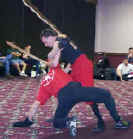 The abandonment by later
generations (living under very different conditions) of techniques which were a
long-established part of the repertoire of many masters does not negate either their
significance or their martial effectiveness (all Hollywood musketeer slapstick aside).
Just because later 18th and 19th century duelists decided certain moves were
"dastardly" and "unsuited" to their notions (artificial or not) of
"fair" gentlemanly contests, does not mean all men fighting for their very lives
in the violent 1500s and 1600s felt the same. As Dr. Anglo has keenly summarized,
"There were many different types of sword, and they were not all handled in the same
way. There were many different masters, and – however much they traveled about to
gain experience, copied each other, or developed similar solutions to similar questions
– they each had their own ideas about how to do things…the history of fencing is
a good deal less straightforward than was at one time supposed". The abandonment by later
generations (living under very different conditions) of techniques which were a
long-established part of the repertoire of many masters does not negate either their
significance or their martial effectiveness (all Hollywood musketeer slapstick aside).
Just because later 18th and 19th century duelists decided certain moves were
"dastardly" and "unsuited" to their notions (artificial or not) of
"fair" gentlemanly contests, does not mean all men fighting for their very lives
in the violent 1500s and 1600s felt the same. As Dr. Anglo has keenly summarized,
"There were many different types of sword, and they were not all handled in the same
way. There were many different masters, and – however much they traveled about to
gain experience, copied each other, or developed similar solutions to similar questions
– they each had their own ideas about how to do things…the history of fencing is
a good deal less straightforward than was at one time supposed". |
|
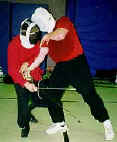 There is little question that
a swordsman in the 1500s & 1600s had to be fully skilled, not just for facing
gentlemen il duello, but for a fight a’ la machia or duel a’ la
mazza (essentially a private less formal quarrel out in the woods by either noble or
commoner). He also had to be ready to defend himself against any unexpected
onslaught, sudden ambush, or assault by strangers. He had to draw his weapon, size up the
situation, face multiple attackers and survive or safely flee. In other words, he had to
be able to fight those who weren’t "playing by the rules". There are
numerous accounts of gentlemen in hot temper vengefully surprising their rivals. Affairs
of honor wherein the adversary stood firm politely announcing, "On guard, sir!"
was the exception not the rule. There is little question that
a swordsman in the 1500s & 1600s had to be fully skilled, not just for facing
gentlemen il duello, but for a fight a’ la machia or duel a’ la
mazza (essentially a private less formal quarrel out in the woods by either noble or
commoner). He also had to be ready to defend himself against any unexpected
onslaught, sudden ambush, or assault by strangers. He had to draw his weapon, size up the
situation, face multiple attackers and survive or safely flee. In other words, he had to
be able to fight those who weren’t "playing by the rules". There are
numerous accounts of gentlemen in hot temper vengefully surprising their rivals. Affairs
of honor wherein the adversary stood firm politely announcing, "On guard, sir!"
was the exception not the rule. |
|
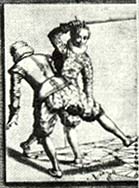 Seizures, disarms, close-in grabs, and left-hand parries have always been
tricky, always been risky, and always required practice in all types of fencing. Perhaps
there have always been fencers too conservative to approve of them or to risk coming
corps-a-corps ("body to body") at all. But this doesn't mean that in the right
circumstances they did not work and cannot work again. These were (and are) advanced
techniques and even for advanced students may not always work perfectly (but then, what
techniques does?). If the circumstances are correct, and they fail, it is the fighter not
the technique which is at fault. Interestingly, some schools and masters were still
teaching grips and seizures up to the 19th century. Against a lighter, shorter blade,
these actions are indeed harder to effect, but that only meant a swordsman would have to
be careful in the attempt -which was true with earlier weapons, as well. Referring to French military duels with "skewers" (epees) of the
1880’s, one author related "If it were not for the prospect of that pointed
rapier before them these soldiers might sometimes kick and maul each other to death." Seizures, disarms, close-in grabs, and left-hand parries have always been
tricky, always been risky, and always required practice in all types of fencing. Perhaps
there have always been fencers too conservative to approve of them or to risk coming
corps-a-corps ("body to body") at all. But this doesn't mean that in the right
circumstances they did not work and cannot work again. These were (and are) advanced
techniques and even for advanced students may not always work perfectly (but then, what
techniques does?). If the circumstances are correct, and they fail, it is the fighter not
the technique which is at fault. Interestingly, some schools and masters were still
teaching grips and seizures up to the 19th century. Against a lighter, shorter blade,
these actions are indeed harder to effect, but that only meant a swordsman would have to
be careful in the attempt -which was true with earlier weapons, as well. Referring to French military duels with "skewers" (epees) of the
1880’s, one author related "If it were not for the prospect of that pointed
rapier before them these soldiers might sometimes kick and maul each other to death." |
|
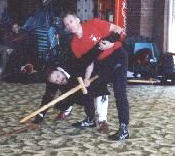 For some sword enthusiasts today, historical fencing means martial
arts, or techniques approached purely for self-defence, i.e., killing skills. For
others, fencing itself seems to mean only the art of the single sword and only when
conducted in a traditional pedagogy of mock dueling (a combat selon
les règles or a combat "according to the rules"). Yet, historians
of dueling have pointed out that in the 1500s and 1600s, little distinction was frequently
made between brawls, sudden affrays, rencounters, private assaults, and "duels"
(either formal or a' la mazza). This distinction even appears to have been the
exception rather than the rule. Some more traditional fencers may see as
"brutal" any earlier style that employs close-in actions, hand and foot blows,
seizures, grappling, and take-downs. This is understandable, as these much ignored and
long overlooked techniques are difficult to learn, dangerous to casually practice, and
highly awkward to safely use in free-play or bouting. They may be considered
"artless", "vulgar", or "base" to attempt to use them
"in place of proper fence". This is a real shame. For these techniques have
historical and martial validity and they can be as fluid and graceful as any weapon and
should they serve to win a life-and death fight, to the winner they are neither improper
nor crude. In Martial Arts of Renaissance Europe, Dr. Anglo, astutely comments on
the styles of fighting in the Renaissance stating: "The techniques involved –
dealing with unequal odds, left hand parrying, wrestling throws, ruthless battering about
the head, stabbings, wards, and a total commitment to death and destruction – are all
much the same as those described and illustrated by masters of arms from the late
fourteenth century onwards. And, however much such behavior may later have been frowned
upon by academic fencers, similar practices were still being taught long after they are
conventionally supposed to have vanished from the sophisticated swordsman’s
repertory." For some sword enthusiasts today, historical fencing means martial
arts, or techniques approached purely for self-defence, i.e., killing skills. For
others, fencing itself seems to mean only the art of the single sword and only when
conducted in a traditional pedagogy of mock dueling (a combat selon
les règles or a combat "according to the rules"). Yet, historians
of dueling have pointed out that in the 1500s and 1600s, little distinction was frequently
made between brawls, sudden affrays, rencounters, private assaults, and "duels"
(either formal or a' la mazza). This distinction even appears to have been the
exception rather than the rule. Some more traditional fencers may see as
"brutal" any earlier style that employs close-in actions, hand and foot blows,
seizures, grappling, and take-downs. This is understandable, as these much ignored and
long overlooked techniques are difficult to learn, dangerous to casually practice, and
highly awkward to safely use in free-play or bouting. They may be considered
"artless", "vulgar", or "base" to attempt to use them
"in place of proper fence". This is a real shame. For these techniques have
historical and martial validity and they can be as fluid and graceful as any weapon and
should they serve to win a life-and death fight, to the winner they are neither improper
nor crude. In Martial Arts of Renaissance Europe, Dr. Anglo, astutely comments on
the styles of fighting in the Renaissance stating: "The techniques involved –
dealing with unequal odds, left hand parrying, wrestling throws, ruthless battering about
the head, stabbings, wards, and a total commitment to death and destruction – are all
much the same as those described and illustrated by masters of arms from the late
fourteenth century onwards. And, however much such behavior may later have been frowned
upon by academic fencers, similar practices were still being taught long after they are
conventionally supposed to have vanished from the sophisticated swordsman’s
repertory." |
|
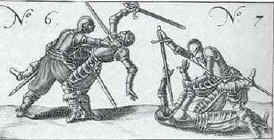 The view that rapiers were too quick to allow successful closing
or grappling is simply untrue. But, it’s understandable that as these moves
weren’t used, they weren’t taught any longer, and not being taught they fell out
of use. One fights the way one trains after all. Wisely, one would not attempt these
actions against an opponent unless one had practiced them considerably in the first place,
otherwise they would certainly be foolish to attempt except in desperation (which did
occur). Surely it is unreasonable to believe that these things could never have happened
because an opponent would be hit before closing to range is not borne out by the available
evidence? Nor is it supported by modern contests between "grappling" versus
"non-grappling fencers". Given the variety and length of rapier blades and
Renaissance swords that existed, and the greater and greater information now coming to
light on the various methods for using them, it would indeed be a difficult proposition to
justify. Thus, today’s historical fencing practitioners should endeavor to experience
the opportunity to go up against someone skilled in them and use caution in declaring
across the board they do not work or would not be effective. The view that rapiers were too quick to allow successful closing
or grappling is simply untrue. But, it’s understandable that as these moves
weren’t used, they weren’t taught any longer, and not being taught they fell out
of use. One fights the way one trains after all. Wisely, one would not attempt these
actions against an opponent unless one had practiced them considerably in the first place,
otherwise they would certainly be foolish to attempt except in desperation (which did
occur). Surely it is unreasonable to believe that these things could never have happened
because an opponent would be hit before closing to range is not borne out by the available
evidence? Nor is it supported by modern contests between "grappling" versus
"non-grappling fencers". Given the variety and length of rapier blades and
Renaissance swords that existed, and the greater and greater information now coming to
light on the various methods for using them, it would indeed be a difficult proposition to
justify. Thus, today’s historical fencing practitioners should endeavor to experience
the opportunity to go up against someone skilled in them and use caution in declaring
across the board they do not work or would not be effective. |
|
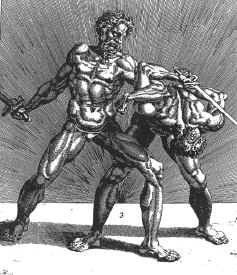 Were grappling and wrestling techniques always used in rapier fencing then? No,
of course not. But has their historical and martial importance to rapier fencing been
overlooked and under appreciated? Yes, from the evidence presented it obviously seems so.
If a fighter could kill or defeat his adversary by skill with his blade alone, he surely
would. That is what wielding the armament is all about after all. But, if opportunity
presented itself and circumstances demanded it, he would utilize every action in his
repertoire. Knowledge of grappling and wrestling would make it all the harder for such
moves to be successfully used against him. We might ponder if there is a gap or hole in a
student’s rapier skills if they are completely ignorant of these techniques, but who
knows? All we can do today is examine the accounts of duels and compare them with the
theoretical instructions in the manuals and our own limited modern experiments. it can be
hard to judge the value these moves contain if modern rapier fencing enthusiasts today do
not themselves regularly practice them, may not even be aware of them, and neither have
used them successfully nor had them employed effectively against themselves. Were grappling and wrestling techniques always used in rapier fencing then? No,
of course not. But has their historical and martial importance to rapier fencing been
overlooked and under appreciated? Yes, from the evidence presented it obviously seems so.
If a fighter could kill or defeat his adversary by skill with his blade alone, he surely
would. That is what wielding the armament is all about after all. But, if opportunity
presented itself and circumstances demanded it, he would utilize every action in his
repertoire. Knowledge of grappling and wrestling would make it all the harder for such
moves to be successfully used against him. We might ponder if there is a gap or hole in a
student’s rapier skills if they are completely ignorant of these techniques, but who
knows? All we can do today is examine the accounts of duels and compare them with the
theoretical instructions in the manuals and our own limited modern experiments. it can be
hard to judge the value these moves contain if modern rapier fencing enthusiasts today do
not themselves regularly practice them, may not even be aware of them, and neither have
used them successfully nor had them employed effectively against themselves. |
|
| Perhaps then, when it comes to fighting with historical hand-weapons, the
very view that there is such a thing as "close-quarter" combat is itself
artificial? Since virtually all "all-out" Medieval and Renaissance combat
involved, or at least anticipated and assumed, close-in techniques of grappling and
wrestling, there was no real necessity to distinguish close-quarter from "non
close-quarter". There was only the need to identify classes of techniques that worked
at one range or another, and were employed either directly by weapon or by empty hand and
body. It would seem it was not until close-in actions were later disavowed or discarded
that a distinction apparently developed. It may very well be that it was only the
structured rules which limited the application of grappling and wrestling, first within
certain tournaments and judicial duels and then the gentlemanly Code Duello, that armed
combat (and fencing in general) came to be characterized as something "other"
than close-combat (i.e., fighting at a range other than the weapon’s
"reach"). |
|
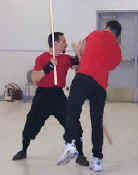 ARMA’s perspective is
that of training and instructing. Hence, our purpose is not academic theorizing but
to interpret and practice this subject as a martial art and to train in these skills --as
close as we can approximate to how they were historically intended to really be used (in a
traditional approach). Since its beginnings ARMA has emphasized seizures,
disarms, grappling, and close entering actions as crucial, vital, and integral elements in
all historical armed combat, including rapier. These actions were real, they were
historical, and they worked. They were used by all manners of fighters from all classes of
society (indeed, they continued to later be described as highly useful by several by 18th
century small-sword masters). In our modern study now we must not suppress them, ignore
them, or make excuses for our ignorance of them because they do not somehow fit a
preconceived notion of how "proper" fencing (whether Medieval or Renaissance)
should have been conducted. Instead, we must expose them, explore them, and try to master
them. ARMA’s perspective is
that of training and instructing. Hence, our purpose is not academic theorizing but
to interpret and practice this subject as a martial art and to train in these skills --as
close as we can approximate to how they were historically intended to really be used (in a
traditional approach). Since its beginnings ARMA has emphasized seizures,
disarms, grappling, and close entering actions as crucial, vital, and integral elements in
all historical armed combat, including rapier. These actions were real, they were
historical, and they worked. They were used by all manners of fighters from all classes of
society (indeed, they continued to later be described as highly useful by several by 18th
century small-sword masters). In our modern study now we must not suppress them, ignore
them, or make excuses for our ignorance of them because they do not somehow fit a
preconceived notion of how "proper" fencing (whether Medieval or Renaissance)
should have been conducted. Instead, we must expose them, explore them, and try to master
them. |
|
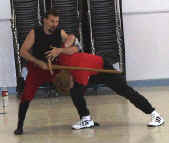 There is certainly far,
far more that can be said about this subject, and grappling and wrestling in Renaissance
fencing alone could easily be separated into two or more distinct areas of research. The
skills of entering in close to grab an opponent’s arm, hand or blade, disarm them or
trap them were used and are something that today’s student of historical fencing
should explore in detail. The techniques of closing to take down or trip up and opponent
can make all the difference in a real sword fight and today are elements worthy of
long-term investigation by Renaissance fencing students. It has often been said that we
should not become prisoners to our style. Good ideas come from everywhere. There are
brilliant ideas in fighting and there are foolish ones. The job of any earnest instructor
is to honestly point them out. To quote the Master Vadi from c. 1480, "You can also
use in this Art strokes and close techniques that you find simpler; leave the more
complex, take those favoring your side and often you will have honour in the Art." There is certainly far,
far more that can be said about this subject, and grappling and wrestling in Renaissance
fencing alone could easily be separated into two or more distinct areas of research. The
skills of entering in close to grab an opponent’s arm, hand or blade, disarm them or
trap them were used and are something that today’s student of historical fencing
should explore in detail. The techniques of closing to take down or trip up and opponent
can make all the difference in a real sword fight and today are elements worthy of
long-term investigation by Renaissance fencing students. It has often been said that we
should not become prisoners to our style. Good ideas come from everywhere. There are
brilliant ideas in fighting and there are foolish ones. The job of any earnest instructor
is to honestly point them out. To quote the Master Vadi from c. 1480, "You can also
use in this Art strokes and close techniques that you find simpler; leave the more
complex, take those favoring your side and often you will have honour in the Art."
The fact is, modern attempts to practice historical fencing
are neither historical nor fencing if they exclude the
crucial elements of grappling and wrestling
as being “too brutal or violent.”
Note: All source references have been removed from the
online verison.
Copyright (C), September 2000, All Rights Reserved.
Back to the Essays Page |
|
|

